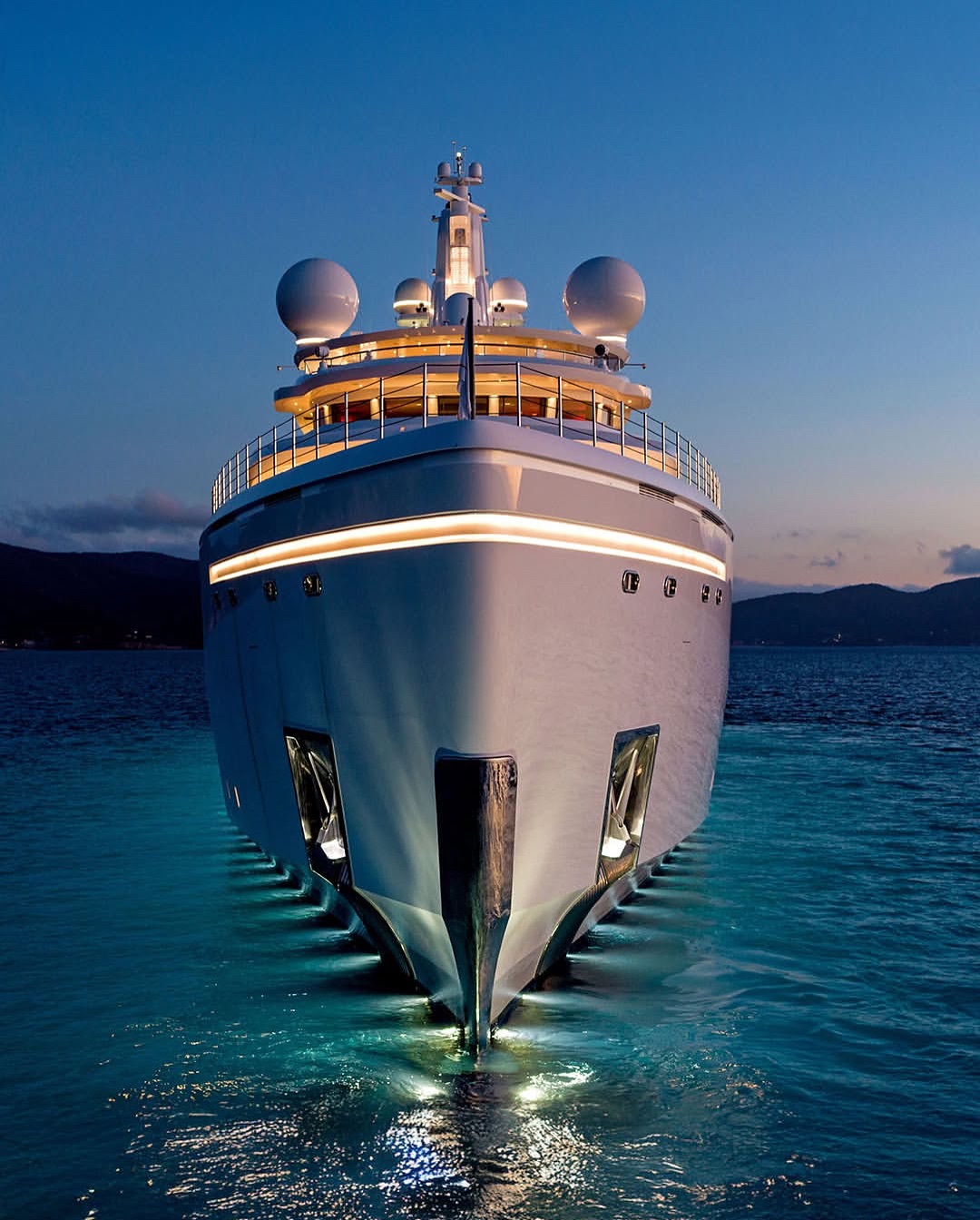Offshore cooking is one of those things that sounds easy – right up until the wind gusts, the deck tilts, and you realize the ocean does not care that you’re trying to sear a ribeye.
I’ve grilled in backyards, competition pits, hunting cabins, and questionable dock bars, but nothing teaches you humility faster than cooking on a moving boat.
This guide is built for the mariner who loves good food and refuses to let the open water bully their barbecue.
We’ll break down the best grills for maritime operations, review the top models, compare specs, and walk through what really matters when you’re cooking on boats, yachts, and ships.
If you want clean answers, practical tips, and a few salty anecdotes – welcome aboard.
What Makes a Marine Gas Grill Different?
And why you absolutely shouldn’t strap your backyard grill to the rail.
There’s a reason real marine grills exist: the ocean is basically a giant grill-destroying machine. Salt, moisture, UV, wind, and motion all team up to chew through cheap metal and knock over wobbly gear.
Here’s what separates a real offshore-ready grill from the “I found this on sale at a warehouse store” option:
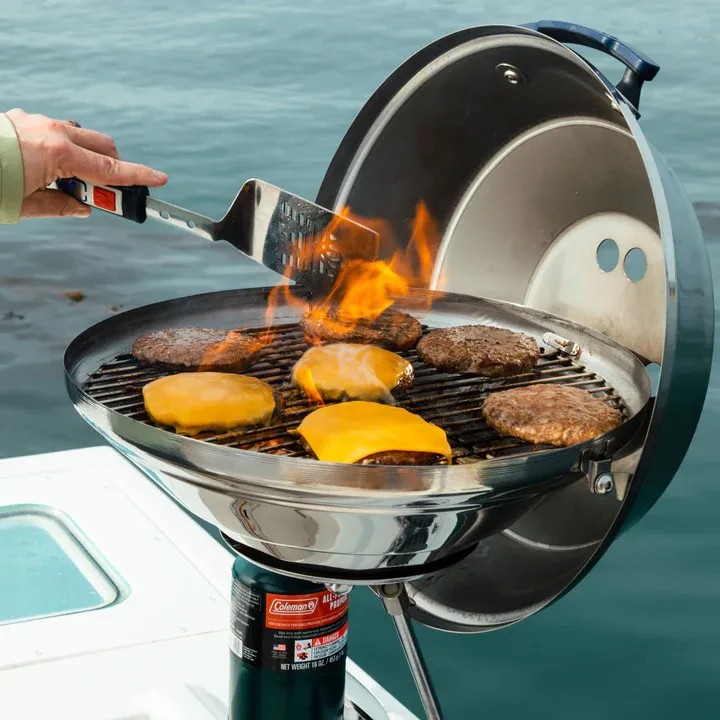
Marine-Grade Materials (304 vs. 316 Stainless Steel)
If you’ve ever watched a cheap grill rust faster than a fishing hook left on a dock, you already know the ocean is the boss.
- 316 stainless steel is the gold standard. It laughs in the face of saltwater.
- 304 stainless steel is the next best – durable, widely used, and perfectly fine for most boaters.
Key point:If the grill doesn’t say what steel it uses, assume it’s the kind that cries in seawater.
Mounting & Stability Systems
Grills on boats need to attach to something – rails, rod holders, brackets, pedestals. The goal:
Lock it down, so the grill doesn’t take a swim.
Important features:
- Rail clamps that don’t wiggle
- Rod-holder mounts
- Pedestal mounts for yachts
- Swivel brackets that allow wind positioning
Pro tip: A grill that “rests on a table” is an accident waiting to happen offshore.
Fuel Type & Efficiency
Fuel choice becomes a big deal when you’re cooking offshore, where wind and motion can change how your grill performs. The right fuel setup keeps heat consistent and helps you stretch every ounce of propane while you’re out on the water.
Most marine gas grills run on 1 lb propane cylinders. Easy, safe, compact.
Bigger yachts may use:
- 20 lb propane tanks
- Natural gas systems
- Built-in fuel lines with shutoff valves
At sea, BTUs matter, but efficiency matters more. Wind burns fuel fast.
Look for grills that can hit high heat without wasting propane.

Size, Weight & Cooking Area
When you’re grilling offshore, the size and weight of your grill matter just as much as its heat output. The right cooking area should match your crew size and your boat’s available space without throwing off balance or making storage a hassle.
Here’s a simple rule:
Smaller boats need smaller grills. Yachts can flex bigger equipment.
Consider:
- Number of burners
- Grate surface area
- Storage footprint
- Weight on your rail or mounts
Or as I like to say:
Don’t put a brisket smoker on a jet ski.
Offshore Safety Features
Offshore grilling adds variables you don’t deal with on land – wind, waves, and a surface that never stops moving. That’s why true marine grills come equipped with safety features designed to keep the flame steady and the cookout drama-free.
Wind + flames = chaos.
You want:
- Reliable igniters
- Anti-flare systems
- Wind-resistant burner bowls
- Automatic shutoff
- Secure lid locks
Safety offshore isn’t optional – it’s survival.
The Best Gas Grills for Offshore Cooking (Reviews)
Deep-dive product reviews from a pitmaster who’s grilled on everything from aluminum skiffs to 50-foot cruisers.
This is the part where we go model by model and talk real performance – not marketing fluff.
Each review includes:
- What’s great
- What’s annoying
- Who it’s best for
- Key specs
- Pitmaster notes from real-world use
Let’s get into it.
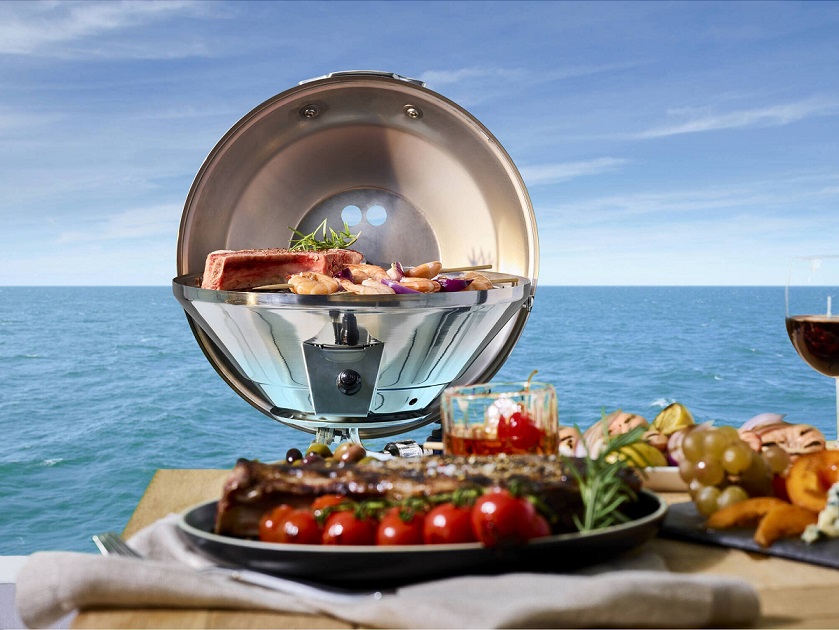
1. Magma Marine Kettle 3 – The Offshore Classic
If you’ve ever walked a marina, you’ve seen this grill. It’s the shiny, round dome hanging off 80% of sailboats. There’s a reason: it just works.
Why it stands out:
- Wind-resistant circular design
- Super stable with proper mount
- Heats evenly for its size
- Lightweight, durable, efficient
If I had to choose one grill to survive the apocalypse on a boat, it’s this one.
Product Specs:
- Material: 18-9 marine-grade stainless
- BTUs: ~7,000–10,000 (depending on model)
- Weight: ~8 lbs
- Cooking Area: ~133 sq in
- Mounts: Multiple options sold separately
Pros:
Nearly rust-proof
- Perfect for high wind
- Quick to heat
- Excellent fuel efficiency
Cons:
- Circular grate limits food layout
- Mounts add to total cost
Best for:
Sailboats, center consoles, runabouts, and anyone who wants a reliable, fuss-free marine grill.
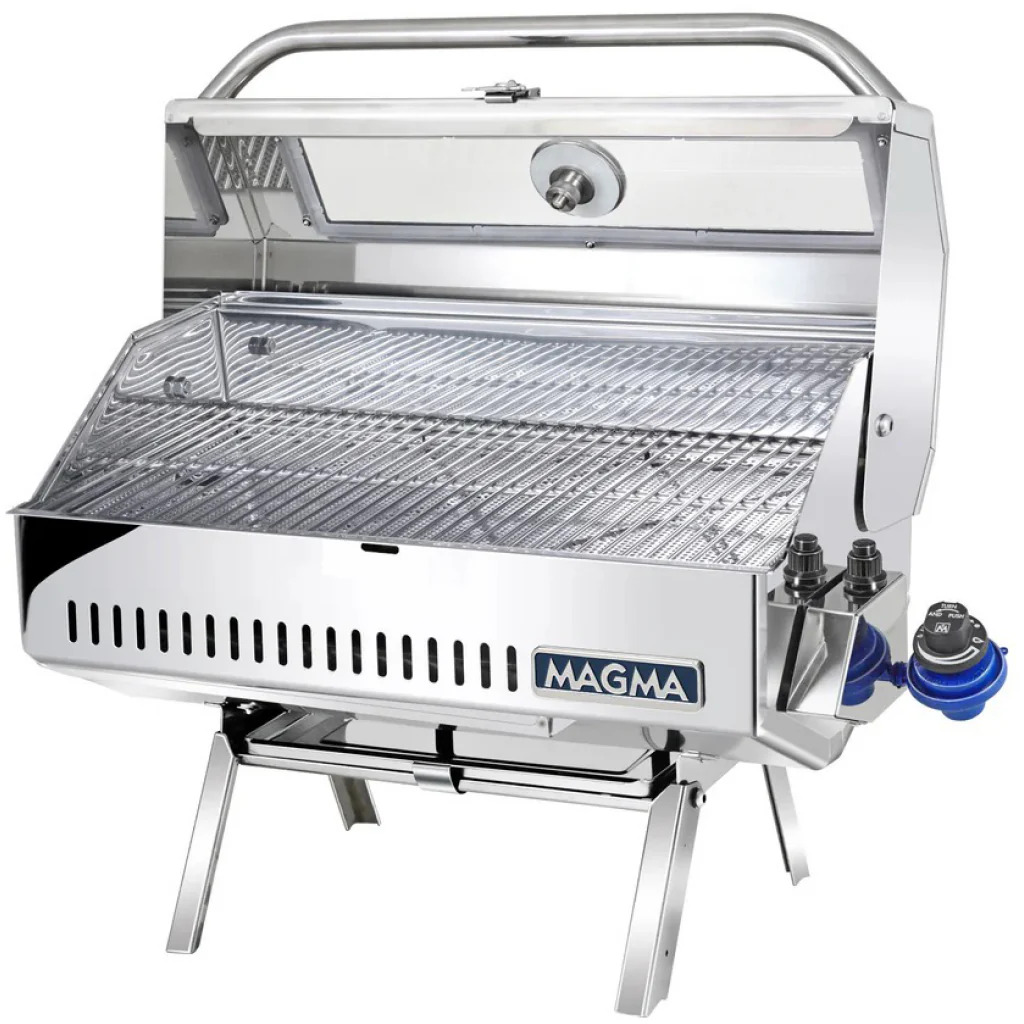
2. Magma Newport II Infrared – The High-Heat Searing Beast
If the Kettle is the classic, the Newport II is the high-performance cousin. This grill is built for serious heat, and the infrared plate means fewer flare-ups and cleaner sears.
Why it stands out:
It’s one of the few true marine grills that lets you get restaurant-quality crust on steaks – even in a breeze.
Product Specs:
- Material: Polished 304 stainless
- BTUs: 12,000
- Weight: ~17 lbs
- Cooking Area: 162 sq in
- Mounts: Rail, rod, side, table
Pros:
- Amazing heat output
- Infrared tech reduces flare-ups
- Big cooking area for its footprint
Cons:
- Uses more fuel
- Needs a sturdy mount
Best for:
Yachts, cruisers, offshore fishermen, charter boats, and cooks who want real searing power.
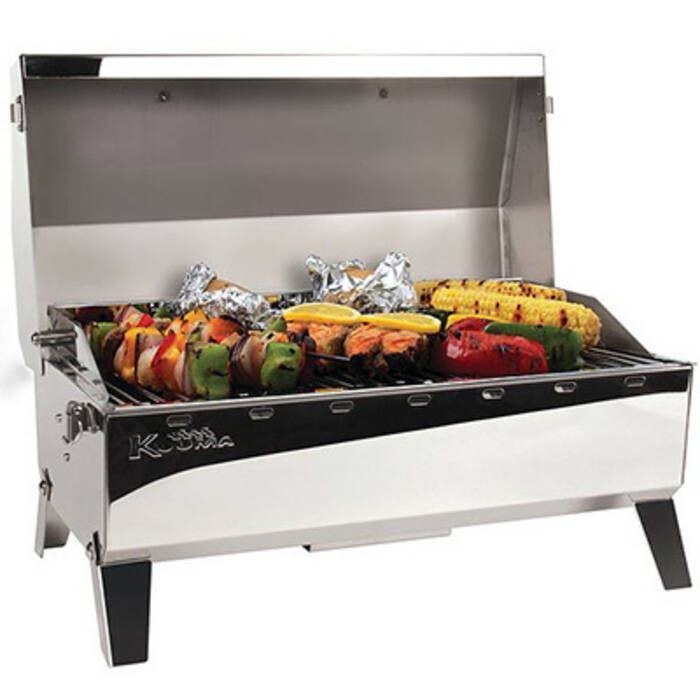
3. Kuuma Stow N’ Go 160 – Simple, Solid, and Boat-Friendly
Kuuma makes tough, no-nonsense marine grills that feel like they were built by someone who actually fishes.
The Stow N’ Go 160 is compact, lightweight, and easy to mount – great for smaller boats.
Product Specs:
- Material: 304 stainless steel
- BTUs: 13,000
- Weight: ~14 lbs
- Cooking Area: 160 sq in
- Mounts: Multiple marine mounts available
Pros:
- Light but durable
- Very even heat distribution
- Larger cooking area than Magma Kettle
Cons:
- Igniter can be finicky
- Hot spots at back edge
Best for:
Center consoles, pontoons, fishing boats, and casual offshore grillers.
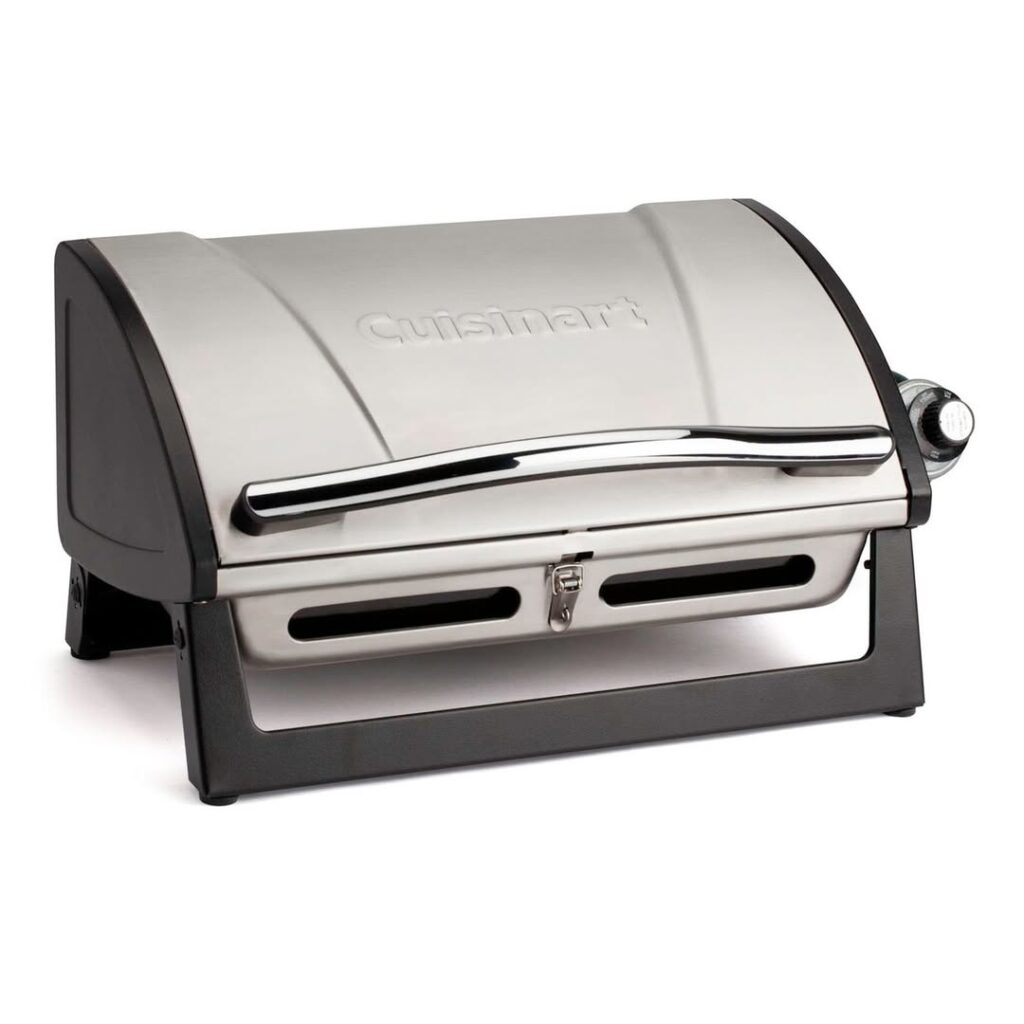
4. Cuisinart Grillster Portable (Marine-Compatible) – Budget Pick That Punches Above Its Weight
Cuisinart isn’t a marine brand, but many boaters adapt the Grillster for light-duty offshore use with aftermarket mounts.
If you’re budget-conscious or don’t grill often, this is a surprisingly good little machine.
Product Specs:
- Material: Coated steel + steel grates
- BTUs: 8,000
- Weight: 10 lbs
- Cooking Area: 146 sq in
Pros:
- Affordable
- Easy to carry
- Decent heat for its size
Cons:
- Not marine-grade
- Rusts faster in salt air
- Requires third-party mount customization
Best for:
Weekend boaters, lake boaters, or anyone wanting low cost without big expectations.
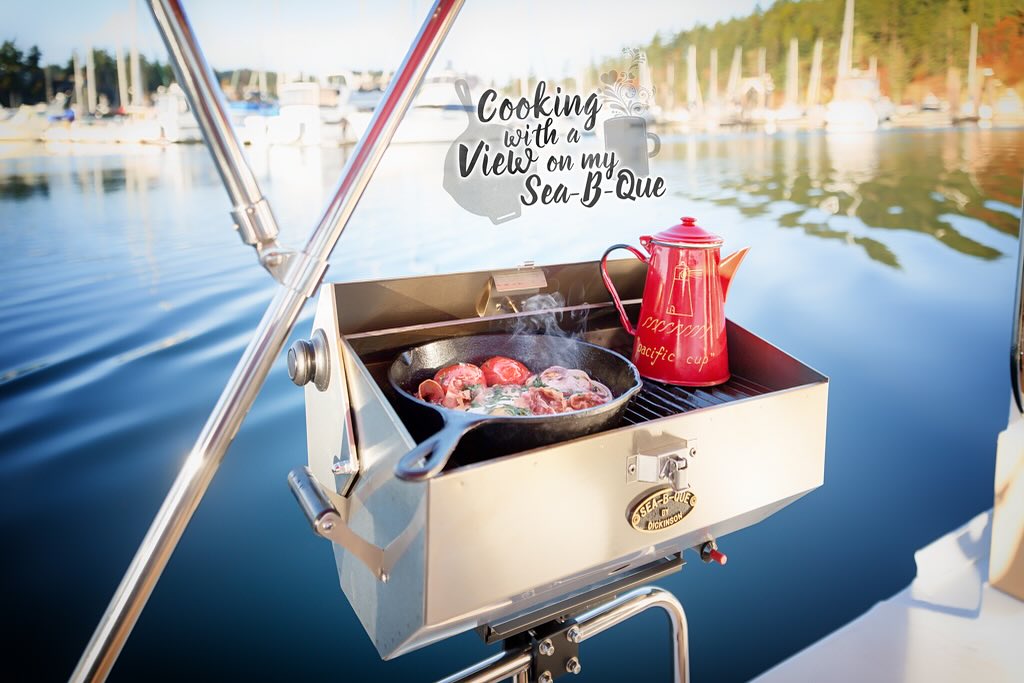
5. Dickinson Sea-B-Que Large – Built Like a Tank
Dickinson makes grills like they expect you to accidentally drop them off the boat and then dive down to retrieve them.
This grill is rugged, high-capacity, and built for larger crews.
Product Specs:
- Material: 304 stainless steel
- BTUs: 11,000
- Weight: 23 lbs
- Cooking Area: 180 sq in
- Mounts: Rail or bulkhead
Pros:
- Big cooking area
- Heavy-duty construction
- Very stable
- Great for long cooks
Cons:
- Heavy
- Uses more fuel
- Requires a strong rail
Best for:
Yachts, liveaboards, trawlers, commercial vessels, and charter operations.

6. Magma ChefsMate Connoisseur Series – The Balanced Performer
This grill sits right in the middle: enough space, plenty of heat, still compact enough for smaller vessels.
Product Specs:
- Material: Polished stainless
- BTUs: 12,500
- Weight: 14 lbs
- Cooking Area: 162 sq in
Pros:
- Strong heat
- Good size
- Reliable construction
Cons:
- Can flare with fatty meats
- Lid gets hot
Best for:
Boaters who want a premium mid-size grill with strong value.

7. Coleman RoadTrip 225 (Marine-Adapted) – The Big-Group Option
Not a marine grill by default, but once adapted with a mount, this unit gives you two burners, more control, and a larger cooking surface than most boat grills.
Not for small boats, but fantastic for bigger platforms.
Product Specs:
- Material: Steel + cast iron grates
- BTUs: 11,000 per burner (22,000 total)
- Weight: ~45 lbs
- Cooking Area: 225 sq in
Pros:
- Huge cooking space
- Two burners = true zone cooking
- Great for big groups
Cons:
- Heavy
- Not marine-grade
- Needs careful mounting
Best for:
Large yachts, party pontoons, houseboats, and dockside cookouts.
Comparison Table – Side-by-Side Look at the Top Offshore Grills
| Model | Weight | BTUs | Material | Cooking Area | Best For |
| Magma Marine Kettle 3 | ~8 lbs | 7,000–10,000 | 18-9 Stainless | 133 sq in | Sailboats, small boats |
| Magma Newport II Infrared | ~17 lbs | 12,000 | 304 Stainless | 162 sq in | Yachts, offshore trips |
| Kuuma Stow N’ Go 160 | ~14 lbs | 13,000 | 304 Stainless | 160 sq in | Fishing boats |
| Cuisinart Grillster | 10 lbs | 8,000 | Mixed steel | 146 sq in | Budget boaters |
| Dickinson Sea-B-Que Large | 23 lbs | 11,000 | 304 Stainless | 180 sq in | Large vessels |
| Magma ChefsMate | 14 lbs | 12,500 | Stainless | 162 sq in | Mid-size boats |
| Coleman RoadTrip 225 | 45 lbs | 22,000 | Steel/Cast Iron | 225 sq in | Yachts, houseboats |

How to Install a Marine Gas Grill Safely
Or: How not to accidentally flambé your deck.
Installing a gas grill on a boat isn’t complicated, but it does demand the right hardware and a little respect for safety. A secure mount and proper ventilation make all the difference between a smooth offshore cookout and a dangerous deckside surprise.
A few quick safety principles learned from years of boat grilling:
Use the right mount
Rail. Rod holder. Pedestal. Pick one designed for your vessel – and never jury-rig it “just for today.”
Avoid enclosed spaces
Propane needs ventilation. Period.
Store fuel properly
Keep propane cylinders upright and away from heat sources.
Use wind strategically
Turn the grill so wind flows around – not into – the flame.
Test your setup before cooking
If it wiggles even a little… tighten it.
Offshore grilling isn’t a place for improvisation unless you want a story that ends with, “And that’s how we lost the starboard rod holder…”
Maintenance Tips for Marine Grills
Salt air is your grill’s natural enemy. After every use:
- Wipe everything down
- Rinse exterior metal with fresh water
- Empty the grease tray
- Lightly oil the grates
- Cover it when stored
A little care goes a long way. Do it right, and your grill will outlive your boat loan.
FAQs
Can I use a regular backyard gas grill on a boat?
You can, but you shouldn’t. They’re not stable or corrosion-resistant enough.
How many BTUs do I need?
10,000–12,000 BTUs is ideal for offshore grilling.
How do I prevent rust?
Rinse with fresh water after every outing and store dry.
Are marine grills safe in rough seas?
Yes – if properly mounted. But grilling in true rough conditions is just showing off.
Final Verdict – Which Grill Should You Buy?
Choosing the right marine grill really comes down to where you sail, how you cook, and how much deck space you’re working with. After testing the top contenders, a few clear standouts rise above the rest for offshore performance, durability, and real-world usability.
Best Overall:
Magma Newport II Infrared
Outstanding heat, great build, versatile, and truly offshore-ready.
Best Budget Pick:
Cuisinart Grillster
Not marine-grade, but great for casual use.
Best for Big Crews:
Dickinson Sea-B-Que Large
Serious capacity and durability.
Most Practical for Most Boaters:
Magma Marine Kettle 3
Reliable, stable, and made for wind.
No matter what boat you run, there’s a perfect grill for you out there – you just need the right combination of durability, performance, and mounting setup.
Featured image credit: @theworldofyachts

